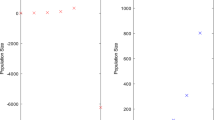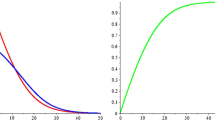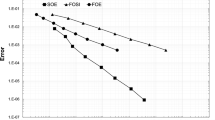Abstract
This paper introduces a method to solve the inverse problem of determining an unknown rate function in a partial differential equation (PDE) based on discrete measurements of the modeled quantity. The focus is put on a size-structured population balance equation (PBE) predicting the evolution of the number distribution of a single cell population as a function of the size variable. Since the inverse problem at hand is ill-posed, an adequate regularization scheme is required to avoid amplification of measurement errors in the solution method. The technique developed in this work to determine a rate function in a PBE is based on the approximate inverse method, a pointwise regularization scheme, which employs two key ideas. Firstly, the mollification in the directions of time and size variables are separated. Secondly, instable numerical data derivatives are circumvented by shifting the differentiation to an analytically given function. To examine the performance of the introduced scheme, adapted test scenarios have been designed with different levels of data disturbance simulating the model and measurement errors in practice. The success of the method is substantiated by visualizing the results of these numerical experiments.







Similar content being viewed by others
References
Abu-Absi NR, Zamamiri A, Kacmar J, Balogh SJ, Srienc F (2003) Automated flow cytometry for acquisition of time-dependent population data. Cytom Part A 51A(2):87–96
Anderson EC, Bell GI, Petersen DF, Tobey RA (1969) Cell growth and division IV. Determination of volume growth rate and division probability. Biophys J 9(2):246–263
Arino O (1995) A survey of structured cell population dynamics. Acta Biotheor 43:3–25
Banks HT, Sutton KL, Thompson WC, Bocharov G, Roose D, Schenkel T, Meyerhans A (2011) Estimation of cell proliferation dynamics using CFSE data. Bull Math Biol 73:116–150
Bell GI (1968) Cell growth and division III. Conditions for balanced exponential growth in a mathematical model. Biophys J 8(4):431–444
Bell GI, Anderson EC (1967) Cell growth and division I. A mathematical model with applications to cell volume distributions in mammalian suspension cultures. Biophys J 7(4):329–351
Bourgeron T, Doumic M, Escobedo M (2014) Estimating the division rate of the growth-fragmentation equation with a self-similar kernel. Inverse Probl 30(2):025007
Diekmann O (1984) The stable size distribution: an example in structured population dynamics. In: Mathematical ecology: proceedings of the autumn course (research seminars) held at the International Centre for Theoretical Physics, Miramare-Trieste, Italy, 1982, no. 54, pp 90-96
Diekmann O, Heijmans HJ, Thieme HR (1984) On the stability of the cell size distribution. J Math Biol 19:227–248
Diekmann O, Lauwerier HA, Aldenberg T, Metz JAJ (1983) Growth, fission and the stable size distribution. J Math Biol 18:135-148
Doumic M (2007) Analysis of a population model structured by the cells molecular content. Math Model Nat Phenom 2(03):121–152
Doumic M, Maia P, Zubelli JP (2010) On the calibration of a size-structured population model from experimental data. Acta Biotheor 58:405–413
Doumic M, Perthame B, Zubelli JP (2009) Numerical solution of an inverse problem in size-structured population dynamics. Inverse Probl 25(4):045008 (pp 25)
Doumic M, Tine LM (2013) Estimating the division rate for the growth-fragmentation equation. J Mathl Biol 67(1):69–103
Doumic-Jauffret M, Gabriel P (2010) Eigenelements of a general aggregation-fragmentation model. Math Mod Meth Appl Sci 20(5):757–783
Doumic-Jauffret M, Hoffmann M, Reynaud-Bouret P, Rivoirard V (2012) Nonparametric estimation of the division rate of a size-structured population. SIAM J Numer Anal 50(2):925–950
Doumic-Jauffret M, Tine LM (2011) A general inverse problem for the growth-fragmentation equation. Technical Report arXiv:1110.4798, INRIA Rocquencour
Eakman JM, Fredrickson AG, Tsuchiya HM (1966) Statistics and dynamics of microbial cell populations. Chem Eng Prog Symp Ser 69(62):37–49
Engl HW, Flamm C, Kügler P, Lu J, Müller S, Schuster P (2009) Inverse problems in systems biology. Inverse Probl 25(12):123014 (pp 51)
Engl HW, Hanke M, Neubauer A (1996) Regularization of inverse problems. Mathematics and its applications, vol 375. Kluwer Academic Publishers, Dordrecht
Engl HW, Rundell W, Scherzer O (1994) A regularization scheme for an inverse problem in age-structured populations. J Math Anal Appl 182(3):658–679
Fredrickson AG, Ramkrishna D, Tsuchiya HM (1967) Statistics and dynamics of procaryotic cell populations. Math Biosci 1(3):327–374
Groh A, Krebs J, Wagner M (2011) Efficient solution of an inverse problem in cell population dynamics. Inverse Probl 27:065009 (pp 25)
Gyllenberg M (2007) Mathematical aspects of physiologically structured populations: the contributions of J A J metz. J Biol Dyn 1(1):3–44
Gyllenberg M, Osipov A, Päivärinta L (2002) The inverse problem of linear age-structured population dynamics. J Evol Equ 2(2):223–239
Gyllenberg M, Osipov A, Päivärinta L (2003) On determining individual behaviour from population data. In: Haroske D, Runst T, Schmeisser H-J (eds) Function spaces, differential operators, and nonlinear analysis: the Hans Triebel anniversary volume. Birkhäuser, Boston
Heijmans HJAM (1984) On the stable size distribution of populations reproducing by fission into two unequal parts. Math Biosci 72(1):19–50
Henson MA (2003) Dynamic modeling of microbial cell populations. Curr Opin Biotechnol 14:460–467
Kohr H (2013) A linear regularization scheme for inverse problems with unbounded linear operators on Banach spaces. Inverse Probl 29(6):065015
Kolewe ME, Roberts SC, Henson MA (2012) A population balance equation model of aggregation dynamics in Taxus suspension cell cultures. Biotechnol Bioeng 109(2):472–482
Laurençot P, Perthame B (2009) Exponential decay for the growth-fragmentation/cell-division equation. Commun Math Sci 7(2):503–510
Liou JJ, Srienc F, Fredrickson AG (1997) Solutions of population balance models based on a successive generations approach. Chem Eng Sci 52(9):1529–1540
Liu YH, Bi JX, Zeng AP, Yuan JQ (2007) A population balance model describing the cell cycle dynamics of myeloma cell cultivation. Biotechnol prog 23(5):1198–1209
Louis AK (1989) Inverse und schlecht gestellte Probleme. Teubner Studienbücher Mathematik, Teubner, Stuttgart
Louis AK (1996) Approximate inverse for linear and some nonlinear problems. Inverse Probl 12(2):175–190
Louis AK (2011) Feature reconstruction in inverse problems. Inverse Probl 27(6):065010 (pp 21)
Louis AK, Maass P (1990) A mollifier method for linear operator equations of the first kind. Inverse Probl 6:427–440
Luzyanina T, Roose D, Schenkel T, Sester M, Ehl S, Meyerhans A, Bocharov G (2007) Numerical modelling of label-structured cell population growth using CFSE distribution data. Theor Biol Med Model 4(26):
Mancuso L, Liuzzo MI, Fadda S, Pisu M, Cincotti A, Arras M, Nasa GL, Concas A, Cao G (2010a) In vitro ovine articular chondrocyte proliferation: experiments and modelling. Cell Prolif 43(3):310–320
Mancuso L, Scanu M, Pisu M, Concas A, Cao G (2010b) Experimental analysis and modelling of in vitro HUVECs proliferation in the presence of various types of drugs. Cell Prolif 43(6):617–628
Mantzaris NV, Liou JJ, Daoutidis P, Srienc F (1999) Numerical solution of a mass structured cell population balance model in an environment of changing substrate concentration. J Biotechnol 71(1–3):157–174
Metz JAJ, Diekmann O (1986) The dynamics of physiologically structured populations. Lecture notes in biomathematics, 68
Michel P (2006a) Existence of a solution to the cell division eigenproblem. Math Mod Meth in Appl Sci 16(Suppl. Issue 1):1125-1154
Michel P (2006b) Optimal proliferation rate in a cell division model. Math Model Nat Phenom 1(2):23–44
Michel P, Mischler S, Perthame B (2005) General relative entropy inequality: an illustration on growth models. J Math Pure Appl 84(9):1235–1260
Perthame B (2006) Transport equations in biology. Frontiers in mathematics. Birkhäuser, Basel
Perthame B, Ryzhik L (2005) Exponential decay for the fragmentation or cell-division equation. J Differ Equ 210(1):155–177
Perthame B, Zubelli JP (2007) On the inverse problem for a size-structured population model. Inverse Probl 23(3):1037–1052
Pilant M, Rundell W (1991a) Determining a coefficient in a first-order hyperbolic equation. SIAM J Appl Math 51(2):494–506
Pilant M, Rundell W (1991b) Determining the initial age distribution for an age structured population. Math Popul Stud 3(1):3–20
Ramkrishna D (2000) Population balances: theory and applications to particulate systems in engineering. Academic Press, San Diego
Ramkrishna D, Fredrickson AG, Tsuchiya HM (1968) On relationships between various distribution functions in balanced unicellular growth. Bull Math Biol 30:319–323
Rieder A, Schuster T (2000) The approximate inverse in action with an application to computerized tomography. SIAM J Numer Anal 37(6):1909–1929
Rieder A, Schuster T (2003) The approximate inverse in action II: convergence and stability. Math comput 72(243):1399–1415
Rundell W (1989) Determining the birth function for an age structured population. Math Popul Stud 1(4):377–395
Rundell W (1993) Determining the death rate for an age-structured population from census data. SIAM J Appl Math 53(6):1731–1746
Schuster T (2007) The method of approximate inverse: theory and applications, vol 1906, Lecture notes in mathematics. Springer, Berlin-Heidelberg-New York
Schuster T, Schöpfer F (2010) Solving linear operator equations in Banach spaces non-iteratively by the method of approximate inverse. Inverse Probl 26(8):085006 (pp 19)
Sidoli FR, Mantalaris A, Asprey SP (2004) Modelling of mammalian cells and cell culture processes. Cytotechnology 44(1):27–46
Sinko JW, Streifer W (1967) A new model for age-size structure of a population. Ecology 48(6):910–918
Sinko JW, Streifer W (1969) Applying models incorporating age-size structure of a population to daphnia. Ecology 50(4):608–615
Sinko JW, Streifer W (1971) A model for population reproducing by fission. Ecology 52(2):330–335
Subramanian G, Ramkrishna D, Fredricksson AG, Tsuchiya HM (1970) On the mass distribution model for microbial cell populations. Bull Math Biol 32:521–537
Tsuchiya HM, Fredricksson AG, Aris R (1966) Dynamics of microbial cell populations. Adv Chem Eng 6:125–206
Webb GF (2008) Population models structured by age, size, and spatial position. Structured population models in biology and epidemiology, vol 1936., Lecture notes in mathematicsSpringer, Berlin, pp 1–49
Wendland H (2005) Scattered data approximation, 1st edn. Cambridge University Press, Cambridge
Yosida K (1995) Functional analysis. Reprint of the sixth (1980) edition. Classics in mathematics, vol 11. Springer, Berlin
Author information
Authors and Affiliations
Corresponding author
Rights and permissions
About this article
Cite this article
Groh, A., Kohr, H. & Louis, A.K. Numerical rate function determination in partial differential equations modeling cell population dynamics. J. Math. Biol. 74, 533–565 (2017). https://doi.org/10.1007/s00285-016-1032-2
Received:
Revised:
Published:
Issue Date:
DOI: https://doi.org/10.1007/s00285-016-1032-2
Keywords
- Inverse problem
- Cell population dynamics
- Partial differential equation
- Parameter estimation
- Population balance equation




